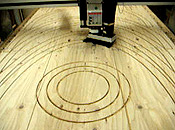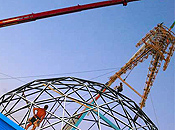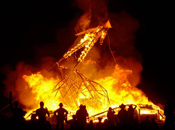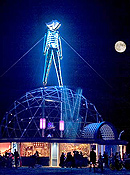The Man team started off 2004 by spending a lot of time reviewing construction plans and updating subtle construction details that had been scratched onto small pieces of paper and somehow saved over the years. This effort resulted in accurate scale drawings of the Man in the form of files that could be used in making the ribs, legs, and arm rings on a computer-controlled router. Some scoffed at the use of technology on a traditionally hand-crafted icon, but in the end no one complained about missing the opportunity to spend 3 days cutting plywood with a jigsaw.
 This process had one interesting side effect: the computer file for the ribs was given to the neon artist, Smoke Daddy, so he could create a perfect match of the torso. But the ribs are cut oversized and cut down at build time, something the neon crew did not know, nor was it communicated to them. The discrepancy made the neon larger than normal, so it wrapped completely around the Man’s torso this year. We inadvertently changed a small detail to an arrangement that had never occurred before, but the change made the figure’s chest seem so much fuller than in the past.
This process had one interesting side effect: the computer file for the ribs was given to the neon artist, Smoke Daddy, so he could create a perfect match of the torso. But the ribs are cut oversized and cut down at build time, something the neon crew did not know, nor was it communicated to them. The discrepancy made the neon larger than normal, so it wrapped completely around the Man’s torso this year. We inadvertently changed a small detail to an arrangement that had never occurred before, but the change made the figure’s chest seem so much fuller than in the past.
Build
The Man crew resided in the rented Gerlach Estates trailer park while working on the project. Every year, the crew goes out to the desert in early July to build the Man for the upcoming event. Six separate pieces (arms, legs, body, and head) are assembled and neatly packed into a box, then stored in a desert hideaway, giving the wood a chance to dry and settle into the shape seen at the event. All went well, and injuries were limited to the occasional splinter or misdirected wood chip. We have had roughly the same crew for almost 4 years, so we all work well together and understand the construction technique involved.
The crew welcomed two new managers for 2004. Because of their lives outside of Burning Man and the nature of the two people, they soon found a working relationship with each other that brought the project to a new level. One worked on the technicalities of the Man’s blueprints and rigging specs, putting the drawings into a workable format and posting them on the Burning Man extranet for others to access when needed. The other manager did the paperwork for the supplies and ordering. This information was also archived on the extranet site for future use. Together they chose the crew, a hand-selected group of return builders.
At the build, each member of the crew was assigned a task. Two of the members started on the legs right away. Next, two were given the arms to complete, and two others created the head. The entire crew then worked together to assemble the body. The Man’s body is the most complex of the pieces and takes just about the whole crew to start and finish.
Once all the parts were completed, the Man was put together in its finished form. We are not sure, but we believe it was the first time in years that the figure had been assembled in this manner before arrival on the playa. Satisfied with the work, we then disassembled the pieces and stored them in the box to wait a little over a month and a half for the event to start.
During the week of the build, crew members have the chance to bond and become friends, and these relationships last well beyond the playa and into the next year. The volunteers come out as devoted members not expecting to be compensated for their work. Each one has a personal reason for coming to the build and working in the desert heat, creating individual devotion to the community and the spirit of the Man itself.
Assembly
Assembling the Man on the ground is a ritualistic process that the crew has been doing for many years. The managers and crew remove components from the box and assemble them once again. If the heat and the dryness don’t get to you, then the anticipation can, since the crew knows that over 30,000 people will be intent on the results of their work. A great deal of time was spent rigging the Man’s arms this year to ensure they would remain raised during the burn. The process is now a stable system that can be repeated each year.
 Pre-event preparations can be a stressful time on the playa. Picking the Man up and placing it atop a pedestal is never easy, and this year was no exception. The week includes attachment of the limbs, with fitting of all the rigging parts and pieces. Assembly continues with wrapping of the figure in wax-dipped burlap bags, placement of the neon, and mapping of the pyrotechnics triggers.
Pre-event preparations can be a stressful time on the playa. Picking the Man up and placing it atop a pedestal is never easy, and this year was no exception. The week includes attachment of the limbs, with fitting of all the rigging parts and pieces. Assembly continues with wrapping of the figure in wax-dipped burlap bags, placement of the neon, and mapping of the pyrotechnics triggers.
 For 2004, the Man’s placement and attachment to the pedestal – composed of a geodesic dome and stilts – was changed. To connect the Man to the stilts, we used steel boots from the 2000 burn recovered from a pile of scrap at the work ranch. Additional steel was welded on in the field to create connectors for the Man to the stilts. Lifting the Man went well, except that the feet were a couple inches too wide and didn’t fit exactly between the dome struts. After pushing and pulling, a little high-wire acrobatics completed the positioning of the feet to the stilts. Guide wires were then attached to the shoulders, and the Man was secure at 11:30 p.m., Saturday before the event opened.
For 2004, the Man’s placement and attachment to the pedestal – composed of a geodesic dome and stilts – was changed. To connect the Man to the stilts, we used steel boots from the 2000 burn recovered from a pile of scrap at the work ranch. Additional steel was welded on in the field to create connectors for the Man to the stilts. Lifting the Man went well, except that the feet were a couple inches too wide and didn’t fit exactly between the dome struts. After pushing and pulling, a little high-wire acrobatics completed the positioning of the feet to the stilts. Guide wires were then attached to the shoulders, and the Man was secure at 11:30 p.m., Saturday before the event opened.
Burn Night
The night of the 2004 burn was anticipated by the crew, who felt great concern about whether the arms would work. The last few years, the arms have failed for various reasons, and this year the crew wanted to get it right. The crew arrived early to help secure the area where arm cables come out of the platform and check with the pyro team that nothing would conflict with the arm rigging. A pre-burn check revealed that not enough wood had been removed from the front of the dome structure where the arm cables exited, so the pyro crew cut larger access holes that would allow free movement of any rigging. We decided to rig the cables so no locks would hold them up or interfere with full extension of the arms (as happened in 2003). The system was simple: Once the arms were raised, we planned to lock the cables to the ground and keep the arms up during the ceremony and most of the burn.
Finally the word was given, and a small crew of six pulled the cables connected to the Man’s arms, which rose at a slow but steady pace. When the arms reached the correct position, they were locked with cline tools. We used this technique for the first time in 2004, with beautiful results. The arms stayed up, and the Man burned quite well. When the fire started, the heat did cause the cables to break, but by then the Man was in flames and the dome had started to collapse.
 The crew had been asked to make sure the Man would burn longer this year than in previous years and fall straight through the dome without a risk of falling forward onto its face. In response, we added bulkier wax and burlap wrapping in the legs and hip area. We believed this would make the legs weaken earlier in the burn than the body, causing the weight to force the figure straight down and not to one side or the other. This plan started to work. Burning started in the legs and hips and then moved slowly to engulf the rest. We did not realize that the stilts and dome would burn much faster than the Man, which collapsed into the burning structure before being fully burned itself.
The crew had been asked to make sure the Man would burn longer this year than in previous years and fall straight through the dome without a risk of falling forward onto its face. In response, we added bulkier wax and burlap wrapping in the legs and hip area. We believed this would make the legs weaken earlier in the burn than the body, causing the weight to force the figure straight down and not to one side or the other. This plan started to work. Burning started in the legs and hips and then moved slowly to engulf the rest. We did not realize that the stilts and dome would burn much faster than the Man, which collapsed into the burning structure before being fully burned itself.
After the Event
 When the burn is over, final inventory is taken of the tools, and they are packed away. Goodbyes are said, and everyone returns home to wait a few more months until the time comes to rebuild the Man. The crew’s destiny is fulfilled by creating one of the world’s most beautiful wooden structures and facilitating its ultimate destruction. We can’t think of many things that could be more fun.
When the burn is over, final inventory is taken of the tools, and they are packed away. Goodbyes are said, and everyone returns home to wait a few more months until the time comes to rebuild the Man. The crew’s destiny is fulfilled by creating one of the world’s most beautiful wooden structures and facilitating its ultimate destruction. We can’t think of many things that could be more fun.
Submitted by,
Ben Stoelting, Shevaun Gallett and Crimson Rose

